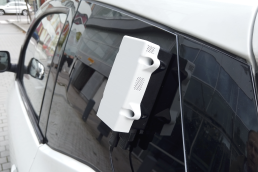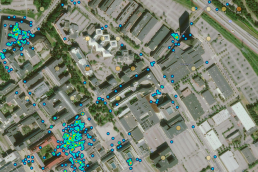Vehicle as a Sensor: Air Quality
Vehicle as a Sensor: Air Quality
Mobile Air Quality Sensors Attached to Vehicles in Kista
The project
Air quality is a matter of life and death affecting the daily lives in our cities. When we collect real-time data of air quality in our connected cities, we could contribute to new solutions and prevent illness. Imagine a future where the bus automatically avoids the most polluted streets or if factories limit their production on certain days, thanks to connected sensors.
In Kista, new sensors for local air quality measurement are tested in a number of projects. In the project Vehicle as a Sensor: Air Quality, Edeva and Smart Sensor Devices explored the possibilities of air quality sensors attached to moving vehicles. The goal was to see how mobile sensors can provide data in ways that complements fixed sensors, and how these two types of measurements interact to provide a better picture of the situation.
Project period
2020
Partners
Kista Science City
Edeva
Smart Sensor Devices
Contact
Eleonor Sjödin Turah
eleonor.sjodinturah@kista.com
Summary
Taking advantage of vehicles used in a last-mile public transport project, Edeva and Smart Sensor Devices tested their air quality sensors by attaching them to the vehicles. This gave them the opportunity to measure both indoor air quality in the vehicles and take GPS-positioned measurements of air quality in the urban environment.
Air quality
The project collected real-time air quality data and use software to visualize and analyze the data. This would test the robustness of the sensors and systems, and how this would work in a real urban setting. The sensors were attached to the vehicles used in the Delta project, taking place between October and December of 2020.
The air quality sensors measured two types of air quality. The sensors from Smart Sensor Devices measured air quality inside the vehicles, while the sensors from Edeva measured air quality in the urban environment around the vehicles. The Edeva readings used GPS positioning to keep track of where those readings were taken, and given a time stamp.
Measurements of air quality are important for different decision-making processes regarding traffic and planning of the urban environments. Many measurements are, however, bound to fixed positions, which will give a snapshot rather than a comprehensive picture of the city. Proving the concept of mobile, GPS-positioned measurements taken continuously will assist municipalities and city authorities in complementing their data in order to have a better foundation for future decisions. Indoor measurements of air quality also helps with this process, as it may give data on how indoor environments are affected by the surrounding environment. It also gives important data about the work environment.
Takebacks
One important takeback from the trials performed within the scope of the project was that it proved to be valuable to measure random, on-demand voyages rather than regular public transports moving on a time table. This enabled measurements on several different locations and times that might otherwise have been missed. It also gives a better picture of “where people are” rather than only the main thoroughfares in an area.
Moving forward
Moving forward, the next steps for the air quality sensors will be to get regular measurements in a larger urban environment. Taking measurements with even shorter intervals, and combining the mobile sensors with fixed sensors at key locations to look more in-depth at certain variables will probably be the optimal combination to provide good data for municipalities and city authorities in the future. This will also provide data over time to see changes from implemented solutions in the environment.


